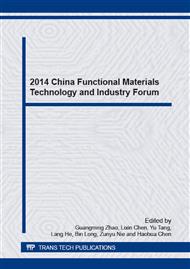p.297
p.302
p.308
p.313
p.319
p.323
p.333
p.348
p.354
Porous Poly(1-naphthylamine) Synthesized by Interfacial Polymerization
Abstract:
Porous poly (1-naphthylamine) were synthesized by interfacial polymerization method. The effects of several reaction conditions including oxidant/monomer molar ratio, polymerization temperature and reaction time on the polymerization yield have been investigated. The highest yield of poly (1-naphthylamine) was up to 73% at oxidant/monomer molar ratio of 3 and polymerization temperature of 25 °C for over 20h. Using FT-IR and XRD to analyze the structure of the obtained polymer, the results show that the main mode of connection for 1-naphthylamine units was linking N to para-C and it formed amorphous polymer with some ordered strutures. The micro-morphology of the polymer observed by SEM was found to have irregular porous structure with pore size less than 5μm, which may be related to the “self-emulsion effect” during polymerization.
Info:
Periodical:
Pages:
319-322
Citation:
Online since:
December 2014
Authors:
Price:
Сopyright:
© 2015 Trans Tech Publications Ltd. All Rights Reserved
Share:
Citation:


